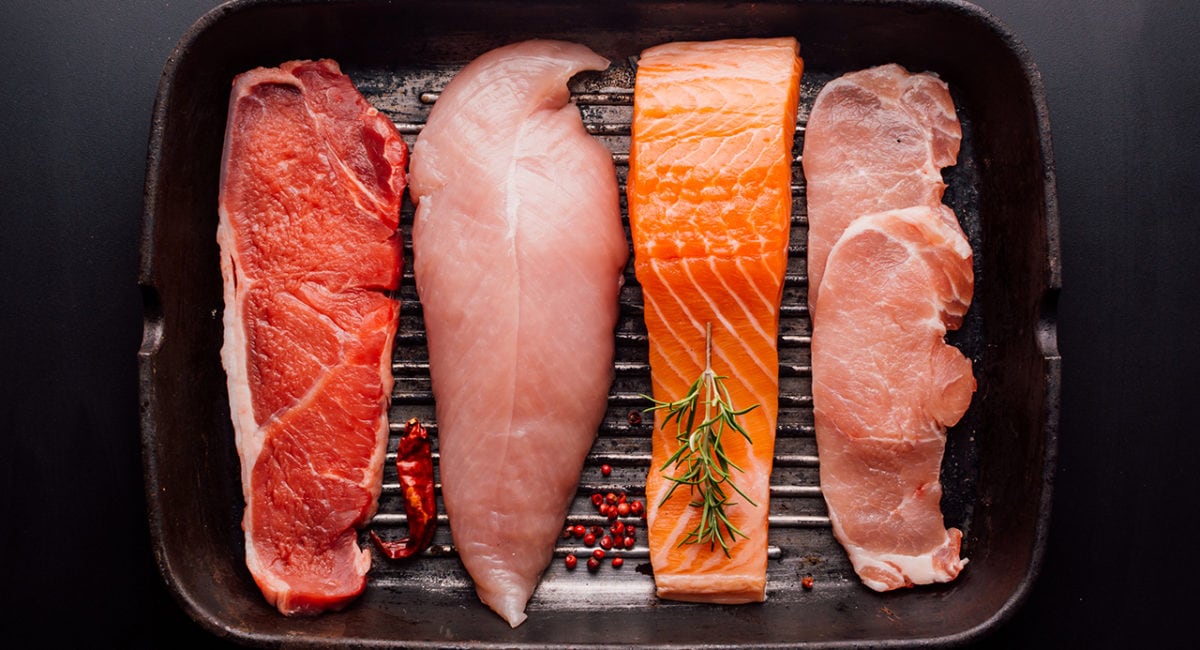Your Guide to Protein on the Most Popular Diets
on /
Do you follow a special diet, or are you curious about trying one out? Are you looking to go keto for weight loss or considering a nutritional reset with the Whole30? Maybe you’re just looking for a healthy maintenance option that has an array of health benefits and still gets you enough protein like the Mediterranean diet.
Whatever the case, you might wonder how much and what sources of protein are recommended for each diet. Can you eat your beloved bacon on the Whole30? Is it possible to eat steak on the keto diet? Can you eat ground beef on the Mediterranean meal plan? You’ll find your answers below, but: In moderation, yes, and not often.
Below, are the details of what experts recommend as the ideal protein intake for each diet, and just what cuts of meat you can and should enjoy.
The Ketogenic Diet (Keto)
You’ve likely heard the word “keto” buzzing about on diet and lifestyle sites and social media, or maybe you’ve recently ventured into keto dieting yourself.
The ultra-low carb diet obviously restricts carbs, while also promoting the intake of quality high fat foods like full-fat dairy, fatty and fiber-rich avocados, grass-fed butter and oils like coconut and avocado oil.
The idea is to push your body into an alternative fat-burning mode called ketosis, a metabolic process that burns ketones rather than your body’s primary fuel, glucose. It’s popular for weight loss, and has also been used therapeutically for a number of conditions, including epilepsy.
So, very little carbs and lots of healthy fats, but what about protein?
While you definitely eat high-quality protein on the keto diet, just how much you should consume is a hotly-contested topic. Experts’ suggestions can vary widely, from 60 to 140 grams of protein a day. To put that in perspective, seven ounces of steak, chicken, or salmon will put you back about 50 grams of protein.
Getting your protein intake on this diet
Truthfully, the exact amount of protein you need to eat to adequately fuel your body and keep it in ketosis will vary. Often, it’s based on your weight, your fitness level, as well as your dietary goals.
But, we’ll go ahead and opt for protein suggestions that fit in a moderate daily protein intake model. Let’s say you have 110 grams of protein for your daily allotment. What should you eat?
- Breakfast: You could opt for a breakfast of bacon, eggs, and avocado, or maybe even a sunny breakfast sausage scramble with avocado. Feel free to add or omit anything you’d like to fit your macros; that’s the beauty of a scramble.
- Lunch: You could opt for four or five ounces of this mouthwatering keto BBQ pulled pork, served with your favorite low carb veggie slaw or even on a slice of keto bread.
- Dinner: Indulge in this low-carb Tuscan chicken dip, which is basically chicken pasta in dip form. Slather it on veggies or keto bread.
The Paleo Diet
Taking its cues from our ancestor’s models of eating, the Paleo diet promotes lots of healthy protein, fresh fruits and veggies, quality fats, nuts, seeds, and more.
On this diet plan, you’ll forgo legumes, grains, dairy, refined sugar, refined vegetable oils, soy, processed foods, and more.
The Paleo diet is touted for being anti-inflammatory, thanks to the nixing of foods like grains and dairy, while also potentially aiding in weight loss.
When it comes to protein, the diet has a reputation for really favoring meat — which is great, because it’s super healthy for you! But, even within the Paleo diet, how much protein you consume is going to vary based on your weight, fitness level, and dietary goals.
You can just as easily eat a low protein diet while keeping Paleo as you could eat a high protein diet. Make the choice that makes the most sense for your health goals.
Getting your protein intake on this diet
The diet opts for a wide variety of protein sources, including fish, seafood, beef, chicken, pork, turkey, game meats, and more. If it’s a quality source of meat, it’s probably fair game (pun intended) on the Paleo diet.
We’ll once again opt for a moderate protein intake plan for these suggestions. With a protein intake like that, your day on the Paleo diet might look like:
- Breakfast: You could fry up some ButcherBox bacon with eggs, sweet potatoes, and peppers and onions, or you could even enjoy a smoky ribeye with sweet potato hash and throw some eggs on top. Omit the feta if you’re strictly Paleo.
- Lunch: This super simple yet flavorful cauliflower bacon soup makes for a great Paleo lunch.
- Dinner: Looking to really indulge at dinner time? This one-pan filet mignon with rosemary brown butter and sautéed veggies is decadent, rich, and delicious. By the way, many Paleo dieters eat grass-fed butter despite its dairy content, but you can sub out the butter in this recipe for ghee, too.
The Whole30
The Whole30 is less a diet than a 30-day program where you reset your nutrition and refocus your relationship with food.
People love it because it helps them with weight loss and improved body composition without counting calories. It’s hailed for improving energy levels and sleep, improving mental clarity, and improving your nutritional understanding and eating habits.
The Whole30 calls for moderate portions of protein sources like seafood, chicken, beef, and pork, as well as lots of vegetables, some fruit, healthy fats, and vibrant seasonings and spices.
You’ll cut out entirely sugar and sweeteners, alcohol, grains, legumes, dairy, processed foods, and even goodies with technically compliant ingredients, like Paleo cakes, muffins, and other baked goods.
Whole30 is much like the Paleo diet, but even more restrictive. Still, many love the 30-day nutritional reset, and, if that’s you, there’s plenty of meaty recipes you can enjoy.
Getting your protein intake on this diet
You’ll notice that the Whole30 singles out “moderate portions of meat,” meaning, once again, we’ll suggest a moderate protein intake with these recipes.
If you’re on a Whole30, consider making these recipes a staple this month.
- Breakfast: Scramble some breakfast sausage with eggs, potatoes, and lots of greens for a simple, nutritious and satiating Whole30 meal.
- Lunch: Dip your favorite veggies in some rich bacon guacamole, which delivers lots of healthy fats and flavor.
- Dinner: Replace taco night with these Instant Pot pork carnitas lettuce wraps with salsa fresca. They’re crisp and satisfying, even without the tortilla.
The Mediterranean Diet
Widely hailed as the diet for longevity, the Mediterranean diet is based on foods found in countries like Italy and Greece back in the day, where residents boasted much healthier profiles than their American counterparts.
The diet promotes lots of plant-based foods, like fruits, vegetables, whole grains, nuts, and seeds. There’s also a healthy intake of extra virgin olive oil and red wine. Protein intake, like the other diets in this article, is moderate, but red meat like ground beef and steak is consumed very rarely.
The well-researched diet is suggested as a long-term, maintenance diet (versus a weight loss diet), though some people do lose weight following a Mediterranean meal plan. It’s been shown to have a number of health benefits including improving cardiovascular health, reversing metabolic syndrome, and reducing the risk of Type 2 diabetes.
Getting your protein intake on this diet
If you’re thinking of going on the Mediterranean diet, you’ll probably nix the red meat most of the time. Still, there are plenty of delicious meals you can make with lean meats and other protein content-rich foods.
- Breakfast: Skip the meat for breakfast on this meal plan, and enjoy eggs with lots of veggies, or yogurt and fruit.
- Lunch: This garlic and lemon marinated chicken breast with brown sage butter is a vibrant, zingy lunch when served alongside a simple green salad with lots of veggies.
- Dinner: These gyro chicken tenders fit within a Mediterranean meal plan, but they’re also inspired by the Mediterranean itself. This pan-seared salmon with green goddess dressing and radish apple salad is also a solid choice.
Grass-Fed Beef Guide
Table of Contents
About Grass-Fed
- What is Grass-Finished Beef?
- Grass-Fed vs. Grass-Finished
- Grass-Fed vs. Grain-Fed
- 100% Grass-Fed Beef vs. Organic Beef
Benefits of Grass-Fed
- Grass-Fed Beef Benefits
- Grass-Fed Beef in the Most Popular Diets
- Is Grass-Fed Beef Better for the Environment?
Buying Grass-Fed
- Grass-Fed Beef in America
- Why It Is Difficult to Find Butcher Shops
- How to Buy Grass-Fed Beef with No Stores Nearby


